Have you ever wondered how search engines like Google determine the display order of your results when you enter a search query? How can you get your website to rank at the top of search engine results pages (SERP)?
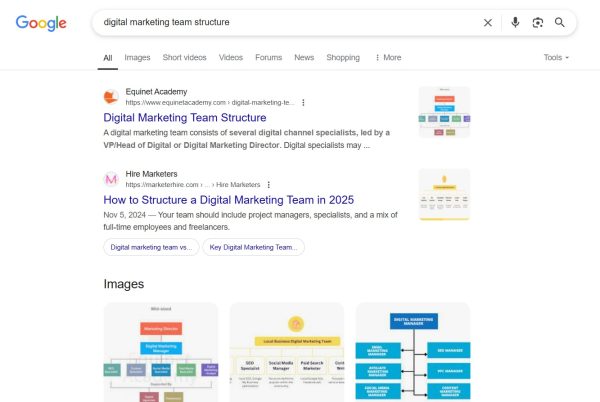
When most people often click on the first three results and rarely venture beyond the first page, optimizing your website so it ranks high on the SERP is important. Otherwise, you are missing out on crucial traffic to boost your business.
Writing great content that people enjoy and engage with is important, but there’s more to it. You want to ensure search engines can find your work easily so that the public can access your work too.
That’s what Search Engine Optimisation (SEO) copywriting is all about. It’s making your writing good for both your readers and search engines.
This intricate balancing act ensures that content not only appeals to the target audience but also aligns with the algorithms that govern search engine rankings.
In digital marketing, SEO copywriting is an important strategy for businesses and content creators to increase their online visibility and attract organic traffic.
The significance of SEO copywriting in digital marketing cannot be overstated. In this time when the internet is saturated with content, standing out in SERP is vital for any businesses and individuals who want to capture the attention of their target audience.
SEO copywriting is the bridge that connects quality content with SEO. One of its key objectives is to improve the visibility of a website.
By strategically adding relevant keywords and phrases that prospective customers are searching for, SEO copywriters can increase the chances of their content ranking higher in the SERP.
This improved visibility is not just about being seen; it’s about being noticed by the right people at the right time to drive targeted, organic traffic to a website.
SEO copywriting goes beyond merely adding keywords in the right places. It’s also understanding the intent behind searches and creating content that addresses the needs and answers questions from the audience.
This approach helps in ranking high on search engines as well as building a connection with readers by speaking directly to them and giving them value.
To achieve this, we introduce the concept of Experience, Expertise, Authoritativeness, and Trustworthiness (E-E-A-T).
E-E-A-T is a vital part of SEO copywriting. These three elements establish the credibility of a website and its content for both users and search engines.
-
- Experience refers to the content creator’s first-hand involvement or practical engagement with the subject matter. Content written from lived experience, such as using a product, visiting a place, or performing a task, tends to resonate more with readers and signals to search engines that the information is authentic and grounded in reality.
- Expertise reflects the depth of knowledge and skill evident in the content, showing the audience that the creator is a trusted authority in their field, capable of offering insights and information that are both accurate and useful.
- Authoritativeness is about establishing the content creator or the website as a thought leader in their field. This can be achieved through well-researched content, citations from reputable sources, and recognition by peers and industry leaders.
- Trustworthiness revolves around the reliability and honesty of the content. It creates an environment where readers feel confident in the accuracy of the information provided and the integrity of the content creator.
Incorporating E-E-A-T into SEO copywriting is as much about adhering to search engine guidelines as it is about building a loyal audience base that trusts and values the content offered. This trust is invaluable and typically shows itself in higher engagement rates, repeat visitors, and conversions.
The Rise of AI in Search Results: What It Means for SEO Copywriting
With the introduction of AI-powered search features like Google’s Search Generative Experience (SGE), the way content appears in search engine results is evolving. Instead of just listing links, AI search now summarises information directly in the results using a blend of trustworthy and relevant sources.
Take the search query “digital marketing job description” as an example. In traditional search, you’d see a list of links to job boards or blog articles. However, with AI-generated results, Google might now generate a concise, conversational summary of what a typical digital marketing role entails, highlighting responsibilities like managing campaigns, analysing data, and developing content strategies. This summary is created using data pulled from high-authority pages.
This shift makes it even more critical for SEO copywriters to:
- Optimise for visibility within AI snapshots, not just the top 10 blue links.
- Structure content clearly, using headers, bullet points, and FAQs so AI can easily parse and include relevant information.
- Strengthen E-E-A-T signals, as AI relies heavily on trustworthy, expert-authored content to generate accurate summaries.
In other words, you’re no longer just writing for humans and traditional search engines — you’re also writing for AI-driven engines that summarise, filter, and feature content in new ways. Ensuring your content is clear, authoritative, and genuinely helpful increases your chances of being referenced in AI snapshots — and gaining visibility, even when users don’t click.
As you delve deeper into the nuances of SEO copywriting, it’s essential to keep these foundational concepts at the forefront.
Let’s get started.
Key Components of SEO Copywriting
Essentially, SEO copywriting is built around a few main elements:
-
-
- Keyword Research and Optimisation: This involves identifying the terms and phrases used when searching for information, products, or services related to your content. By strategically adding these keywords into your content, search engines can better understand what your pages are about, therefore increasing the likelihood of your content ranking higher in relevant searches.
- Content Relevance and Quality: High-quality, relevant content is important. It’s not enough to sprinkle keywords throughout your text; the content itself must be informative, engaging, and valuable to the audience. This means providing answers to your reader’s questions, solutions to their problems, and insights that enrich their understanding of the topic.
- User Experience (UX): The structure and layout of your content play a significant role in SEO copywriting. Content should be organised and presented in a way that makes it easy for your audience to read, understand, and interact with. This includes the use of headings, subheadings, bullet points, and images to break up text and enhance readability.
- Meta Tags and Descriptions: These HTML elements provide concise summaries of the web page content to search engines and users. A well-crafted meta title and description give readers a comprehensive insight into what your page is about and why it is relevant to them, hence improving the click-through rate (CTR) of your page.
-
The Role of Keywords
Keywords are the cornerstone of SEO copywriting. When you use keywords effectively, the chances of search engines finding your content relevant to specific queries increase, hence boosting your visibility in SERP.
However, keyword stuffing or overusing keywords can lead to penalties from search engines and degrade the quality of your content.
Keyword stuffing is the excessive use of keywords on a web page in an attempt to manipulate the search engine’s ranking algorithms. While keyword stuffing was once an effective method for improving search visibility, search engines have since evolved and now deprioritise such content. Hence, it is important to recognise the signs of keyword stuffing to avoid it in your content.
Here’s an example:

Image source: seranking
Visible keyword stuffing occurs when specific keywords or numbers are repeatedly and unnaturally used within content, making it obvious to readers.
Understanding User Search Intent
Understanding your users’ search intent is important for creating content that meets their needs. Search intent is the reason behind the user’s search query and what they hope to find or achieve.
Generally, there are four types of search intent:
-
- Informational: Your reader is looking for information on a particular topic. For example, their search queries could be “How to make French toast” or “Why is the sky blue?”
These queries often start with question words like who, what, where, why, and how, indicating the user’s desire to learn something new or understand a topic better. - Navigational: Your reader is trying to get to a specific website or page.
Examples include direct queries like “Facebook login” or “Google Translate,” where the search result would lead them directly to their destination in mind. A slightly more open-ended example is “YouTube fitness channel,” for instance, when they have a predetermined range of destinations they would like to land on. - Commercial Investigation: Your reader is considering a purchase and wants to compare options.
- Transactional search intent refers to users who are ready to take a specific action, typically making a purchase or completing a conversion-related task. These users have already done their research and made a decision—they’re now looking for the best place to act on it.
- Informational: Your reader is looking for information on a particular topic. For example, their search queries could be “How to make French toast” or “Why is the sky blue?”
By aligning your content with the reader’s search intent, you can create more relevant and valuable content that addresses their specific needs and questions, thereby improving engagement and satisfaction.
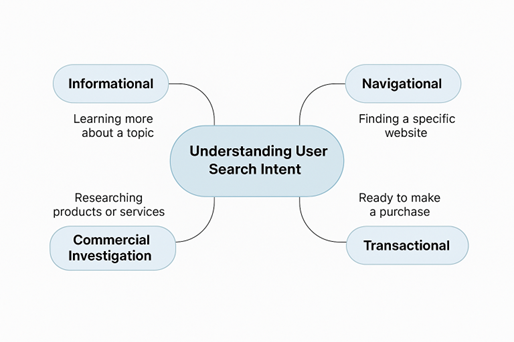
Creating a Balance between Writing for Humans and Search Engines
The ultimate challenge in SEO copywriting is balancing the need to appeal to search engines and to engage and inform the reader. To achieve this balance, it involves:
-
- Writing naturally: Your content should read smoothly, with seamless integration of the keywords. It should address your needs and interests, providing real value.
- Focusing on quality: Creating high-quality content is more likely to get you backlinks, shares, and engagement—all of which are positive signals to search engines.
- Optimising technical elements: While the content needs to be engaging for your readers, you must also pay attention to the technical aspects like meta tags, headings, and URL structure to ensure search engines can crawl and index the content effectively.
- Writing naturally: Your content should read smoothly, with seamless integration of the keywords. It should address your needs and interests, providing real value.
Getting Started with SEO Copywriting
Starting your journey as an SEO copywriter is an exciting opportunity to combine creativity with strategic thinking. Here’s a step-by-step guide to help you get started.
Step 1: Research – Understanding Your Audience and Niche
The first step in your SEO copywriting journey is to thoroughly understand who you’re writing for and the niche you’re addressing. This involves:
-
- Identifying Your Target Audience: Consider who your ideal readers are, including their demographics, interests, and pain points. When you understand your audience, you’ll know the tone, style, and content to use in your writing.
- Analyse their Niche: Research specific topics, trends, and questions that are common in your niche. This will help you create content that’s not only relevant but also timely and will interest your audience.
- Identifying Your Target Audience: Consider who your ideal readers are, including their demographics, interests, and pain points. When you understand your audience, you’ll know the tone, style, and content to use in your writing.
Step 2: Keyword Research – Tools and Techniques for Finding the Right Keywords
Using the right keywords for your content will go a long way to determine how well it performs with both your audience and search engines. With this in mind, you need to ensure you’re using the right tools and techniques.
Here’s how to go about doing so.
Carry out Keyword Research
-
- Use Keyword Tools: Take advantage of tools such as Google Keyword Planner or SEMrush to find relevant keywords, their search volumes, and competitiveness.
- Search Intent: Match your keywords with the intent behind your users’ searches—informational, navigational, transactional, or investigational. Next, tailor your content effectively.
- Long-Tail Keywords: Incorporate specific, less competitive keyword phrases that closely match your audience’s search queries.
- Use Keyword Tools: Take advantage of tools such as Google Keyword Planner or SEMrush to find relevant keywords, their search volumes, and competitiveness.
Planning and Structuring Your Content
-
- Content Outline: Plan a clear structure with an introduction, body, and conclusion to guide your writing process.
- Headings and Subheadings: Use these to break your content into sections. They also improve readability and make it easy for your readers and search engines to follow.
- Multimedia Elements: Enhance your content with images, videos, or infographics to support your text and engage your audience.
- Content Outline: Plan a clear structure with an introduction, body, and conclusion to guide your writing process.
Incorporating E-E-A-T
-
- Show Expertise: Offer well-researched and detailed content backed by data and examples to demonstrate your knowledge.
- Establish Authoritativeness: Gain credibility by earning backlinks from reputable sites and engaging with your community.
- Uphold Trustworthiness: Cite credible sources, keep your content updated, and ensure your website is secured to build trust with your audience.
- Show Expertise: Offer well-researched and detailed content backed by data and examples to demonstrate your knowledge.
With these steps, you’re ready to begin creating content.
Remember, quality and readability are non-negotiable — write for your audience first, using keywords naturally, and continually refine your approach based on feedback and performance metrics.
Optimising Your Copy for SEO
Optimising your copy for SEO is a meticulous process that enhances your content’s visibility and effectiveness. This optimisation ensures that your content not only reaches your target audience but also provides a compelling user experience that search engines reward with higher rankings.
To understand this better, let’s take a look at Tharawat Magazine, a family business and entrepreneurial magazine that has made the most of SEO.
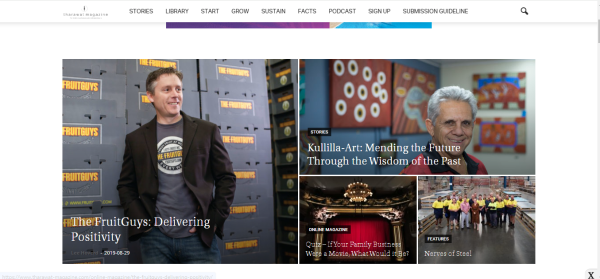
Image source: Tharawat Magazine
By cleaning up and structuring over 1,000 articles, Tharawat Magazine saw a 321% increase in traffic within five months. All thanks to an SEO-friendly editorial plan developed since their team gained a better understanding of SEO and how it works.
Optimising Titles, Headings, and Meta Descriptions
Your titles, headings, and meta descriptions are the front door to your content. They invite users and search engines to understand the value your content offers.
-
- Titles: Create compelling titles that include your primary keyword. Your title should be descriptive, giving users a clear reason to click, and ideally under 60 characters to ensure it displays fully in search results.
For instance, “Garden Like a Pro: 10 Beginner Tips for Green Thumbs” concisely describes the subsequent content, includes the primary keywords, and lets the readers know to expect a structured list of tips. - Headings: Use headings (H1, H2, H3, etc.) to structure your content logically. Include keywords in your headings, but prioritise readability and relevance to guide your readers through the content.
- Meta Descriptions: Write concise meta descriptions, ideally under 160 characters, that summarise the page content. Include your target keyword and a call to action to encourage clicks from the search results.
- Titles: Create compelling titles that include your primary keyword. Your title should be descriptive, giving users a clear reason to click, and ideally under 60 characters to ensure it displays fully in search results.
Keyword Placement and Density
Keywords are the cornerstone of SEO copywriting, but overusing them can lead to penalties for keyword stuffing. To avoid keyword stuffing:
-
- Natural Integration: Place your primary keyword in the first 100 words of your content, signalling its relevance to search engines.
- Variety and Synonyms: Use synonyms and related terms to enrich the context of your content and avoid repetitive keyword use.
- Keyword Density: Aim for a natural flow, with a keyword density of 1-2%, ensuring your content remains readable and engaging.
Using Internal and External Links
Links are the pathways that connect your content to the broader web, enhancing its value and authority.
-
- Internal Links: Links to other relevant pages on your website that guide users to additional content, keeping them engaged and reducing bounce rates.
- External Links: Links to authoritative external sites that provide further context or evidence. This not only enriches your content but also shows search engines that you’re connected to the wider web of information.
- Internal Links: Links to other relevant pages on your website that guide users to additional content, keeping them engaged and reducing bounce rates.
Optimising Images and Multimedia Elements
Images and multimedia elements can significantly enhance user engagement, but they need to be optimised for SEO to contribute to your content’s performance.
-
- Descriptive File Names: Use clear and descriptive file names for your images, adding relevant keywords where appropriate.
- Alt Text: Add alt text to every image, describing the content and context of the image. This improves accessibility and helps search engines understand the relevance of the image.
- Compression and Format: Optimise your images for fast loading by compressing them and using web-friendly formats like JPEG or PNG.
- Descriptive File Names: Use clear and descriptive file names for your images, adding relevant keywords where appropriate.
Addressing “People Also Ask” Questions
Adding answers to “People Also Ask” (PAA) questions within your content can significantly enhance its visibility and relevance.
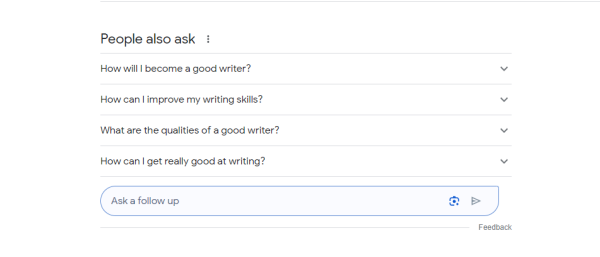
-
- Identify Common Questions: Use tools like Google’s “People Also Ask” feature or Answer the Public to find common questions related to your topic.
- Direct Answers: Structure your content to provide clear, concise answers to these questions, potentially capturing featured snippet positions in search results.
- Identify Common Questions: Use tools like Google’s “People Also Ask” feature or Answer the Public to find common questions related to your topic.
Optimising Copywriting for SEO
-
- Focus on content quality and relevance, ensuring your writing addresses the needs and interests of your audience.
- Use SEO tools and plugins to analyse your content for SEO friendliness, checking for keyword optimisation, readability, and meta tag effectiveness.
- Stay updated with SEO trends and algorithm changes, continuously refining your strategies to maintain and improve your content’s search performance.
By adding the above strategies to your SEO copywriting, you ensure that your content is not only valuable to your audience but also performs well in search engine rankings, driving traffic and engagement to your site.
Exploring Long-Tail Keywords for Niche Targeting
Long-tail keywords are extended phrases that are highly specific to what your audience is searching for. These keywords often have lower search volumes but show high intent, making them valuable for niche targeting.
-
- Identify Long-Tail Opportunities: Use keyword research tools to find long-tail keywords that align with your audience’s specific queries and interests.
- Tailor Content to Match: Create content that directly addresses the queries associated with long-tail keywords. This specificity can significantly improve the relevance of your content and attract a more targeted audience.
- Identify Long-Tail Opportunities: Use keyword research tools to find long-tail keywords that align with your audience’s specific queries and interests.
The Role of Semantic Search and Latent Semantic Indexing (LSI) Keywords
Semantic search refers to the ability of search engines to understand the context and intent behind a user’s query, rather than just the literal words.
-
- Fit in Contextual Keywords: Add LSI keywords that naturally complement your main keywords to enrich the context of your content. This approach helps search engines understand the topic and relevance of your content better.
- Focus on Topic Clusters: Organise your content around central topics, using related subtopics and keywords to create a comprehensive coverage of the subject. This not only aids semantic search but also establishes your authority on the topic.
Strategies for Creating Evergreen Content
Evergreen content remains relevant and valuable to your audience over time, continually attracting traffic and engagement.
-
- Choose Timeless Topics: Focus on topics that maintain their importance and relevance regardless of trends or time.
- Update Regularly: Keep your evergreen content updated with the latest information, statistics, and trends to ensure it remains accurate and valuable.
- Optimise for Search: Ensure your evergreen content is fully optimised for SEO with relevant keywords, headings, and meta tags that reflect the enduring nature of the topic.
Add Storytelling and Emotional Triggers to your Content
Storytelling and emotional triggers can significantly enhance user engagement by making your content more relatable and memorable.
-
- Use Narrative Structures: Craft your content with a clear narrative that takes your audience on a journey, making complex information more digestible and engaging.
- Evoke Emotion: Integrate emotional triggers that resonate with your audience’s desires, fears, and aspirations. This emotional connection can increase engagement and encourage sharing.
- Personalise Your Content: Include personal anecdotes, case studies, or customer stories to add a human touch to your content, making it more relatable and trustworthy.
- Use Narrative Structures: Craft your content with a clear narrative that takes your audience on a journey, making complex information more digestible and engaging.
Leveraging Tools and Technology
In SEO copywriting, making use of the right tools and technology can greatly enhance your efficiency and effectiveness. For beginners, understanding which tools to use and how to apply them can make the journey into SEO content creation much smoother and more productive.
Essential SEO and Content Writing Tools for Beginners
There are several key tools to help beginners navigate the complexities of SEO and content writing. Here are some you should explore:
-
- Keyword Research Tools: Platforms like Google Keyword Planner, Ubersuggest, and SEMrush provide powerful functionalities to discover and analyse keywords, providing insights into search volumes, competition, and related terms.
- Content Optimisation Tools: Yoast SEO, a popular WordPress plugin, provides real-time feedback on the SEO friendliness of your content, guiding you on readability, keyword density, and meta tags. Similarly, tools like Clearscope and Surfer SEO help optimise content based on top-performing competitors, suggesting improvements for better rankings.
- Plagiarism Checkers: Tools such as Copyscape and Grammarly ensure your content is original and free from unintentional plagiarism, maintaining the integrity and trustworthiness of your work.
- Keyword Research Tools: Platforms like Google Keyword Planner, Ubersuggest, and SEMrush provide powerful functionalities to discover and analyse keywords, providing insights into search volumes, competition, and related terms.
Using ChatGPT and Other AI Tools for SEO-Optimised Content
AI writing assistants like ChatGPT can significantly enhance your content creation workflow, especially when it comes to SEO-focused articles. From brainstorming ideas to generating structured drafts, these tools help speed up the writing process while ensuring your content remains relevant, keyword-optimised, and engaging. Here’s how to maximise their value:
1. Content Ideation
Use ChatGPT to spark content ideas based on your core topic or keyword. Simply input your main keyword and ask for a list of blog post ideas, angles, or frequently asked questions that your audience might be searching for.
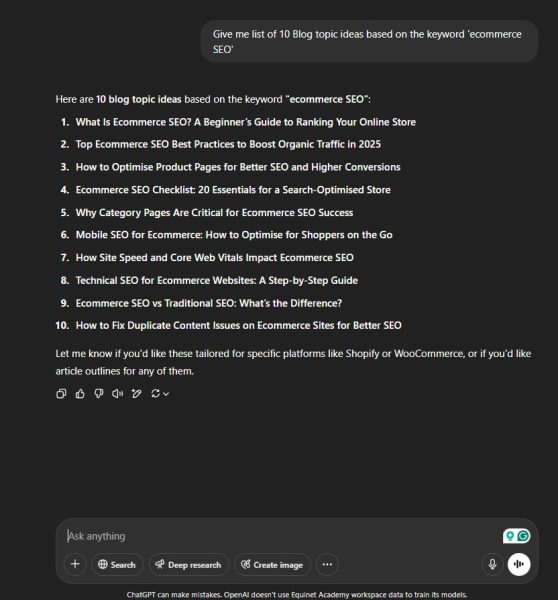
2. Drafting and Structuring Content
ChatGPT is a great tool for generating outlines and even drafting sections of your content. It helps overcome writer’s block and speeds up the initial draft process. Begin with an outline request, then dive into writing individual sections based on those headings.

3. Incorporating SEO Elements
Ask ChatGPT to suggest keywords, headings, and common questions people ask related to your topic. These can guide your content structure and ensure you include SEO-friendly elements like long-tail keywords and featured snippet opportunities.
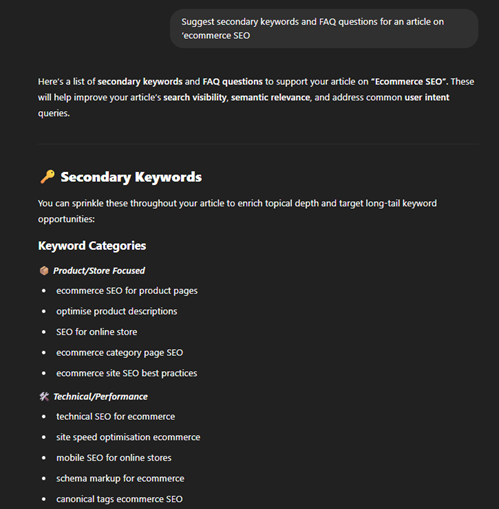
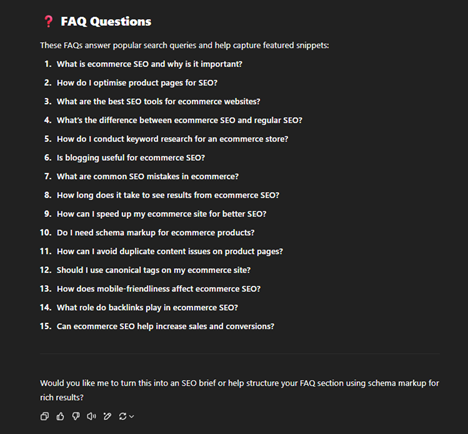
4. Writing the First Draft
With your outline in place, you can ask ChatGPT to generate paragraph drafts for each section. While it may not be perfect, it gives you a strong base that you can edit, enhance, and personalise for your audience.
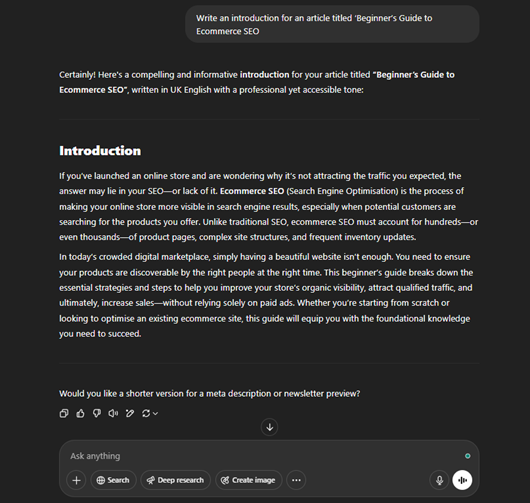
5. SEO Review and Optimisation
While ChatGPT can insert keywords naturally, always run your draft through an SEO tool like Yoast, SurferSEO, or NeuronWriter to check for keyword distribution, readability, meta tags, and title structure. Use the tool’s suggestions to fine-tune your draft for maximum performance.
Writing SEO-Optimised Content with ChatGPT
-
- Define Your Goal: Clearly outline what you aim to achieve with your content. Provide ChatGPT with context about your topic, target audience, and desired keywords.
- Generate an Outline: Request an outline from ChatGPT based on your topic and keywords. This outline should include potential headings and subheadings that structure your content logically.
- Draft Content: Use ChatGPT to draft sections of your content. You can ask for specific paragraphs under each heading, ensuring the content is relevant and informative.
- Add Keywords: While ChatGPT can integrate keywords naturally, review the content to ensure your primary and secondary keywords are evenly distributed, especially in key areas like the introduction, headings, and conclusion.
- Optimise for SEO: After drafting, use traditional SEO tools to check the optimisation level of your content. Refine based on feedback, adjusting keyword placement, meta descriptions, and title tags as needed.
- Define Your Goal: Clearly outline what you aim to achieve with your content. Provide ChatGPT with context about your topic, target audience, and desired keywords.
Conclusion
In this comprehensive exploration of SEO copywriting, we’ve covered the foundational aspects necessary for creating content that not only engages readers but also ranks favourably in search engine results.
Starting with the basics, we talked about the importance of understanding your audience and niche, followed by the intricacies of keyword research and content structuring for enhanced readability and engagement. We emphasised the significance of incorporating E-A-T into your SEO strategy to establish credibility and trust with your audience.
We also explored advanced techniques such as leveraging long-tail keywords for niche targeting, understanding the role of semantic search and LSI keywords, and the art of creating evergreen content that retains its value over time.
The power of storytelling and emotional triggers was discussed as a means to deepen user engagement and make content more memorable.
In addition, we introduced essential tools and technologies that can aid beginners in their SEO copywriting journey, including how AI tools like ChatGPT can assist in generating SEO-optimised content. We provided a step-by-step guide on how to harness these tools effectively.
As we conclude, it’s important to emphasise the dynamic nature of SEO copywriting. The landscape is constantly evolving with search engines continually updating their algorithms. Staying informed about the latest trends and best practices in SEO is vital for maintaining and improving the performance of your content over time.
If you’d like to improve your skills further or want to join a community of like-minded individuals, consider enrolling in the Copywriting and Content Writing Course at Equinet Academy.
Never Miss a Post
Receive the latest blog articles right into your inbox.
Chris Minjoot
Chris is a senior Marketing & Communications professional with over 31 years’ experience as both an in-house practitioner and as a consultant servicing clients from a wide range of industries. He possesses the unique combination of strategic, creative, technical and writing skills critical for today’s integrated marketing needs. Chris is currently also the lead trainer for the Copywriting and Content Writing Course here at Equinet Academy.
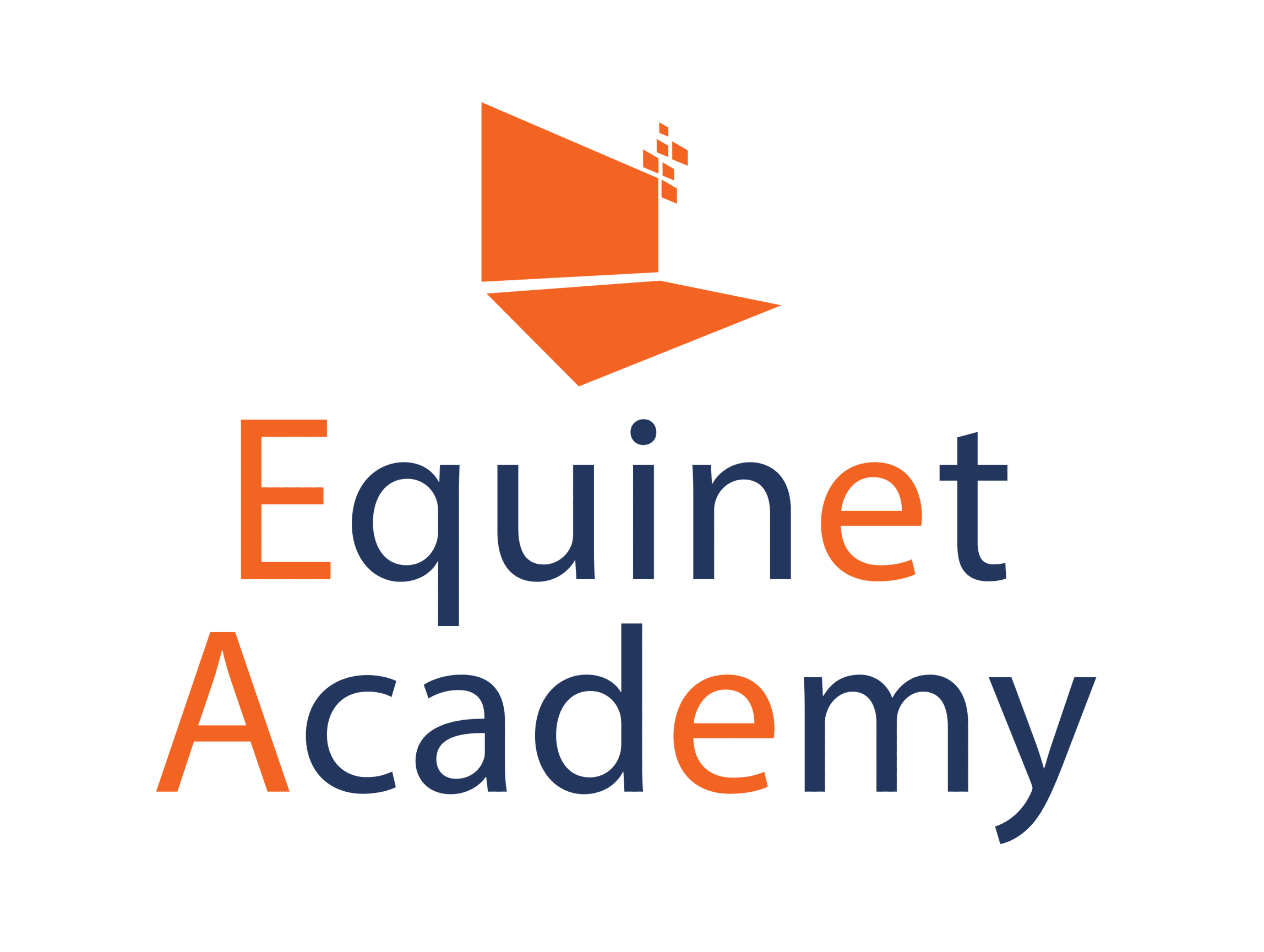





Reader Interactions